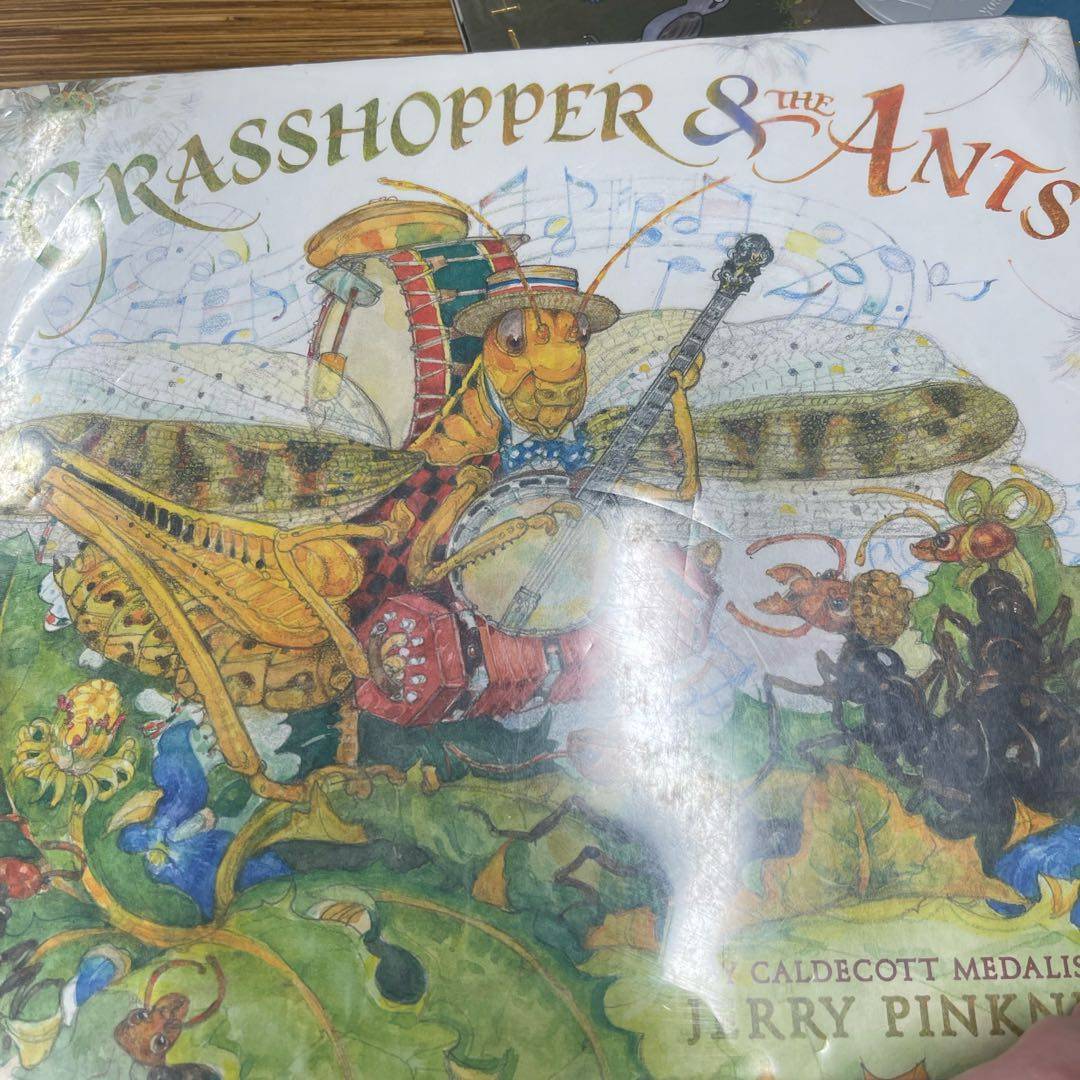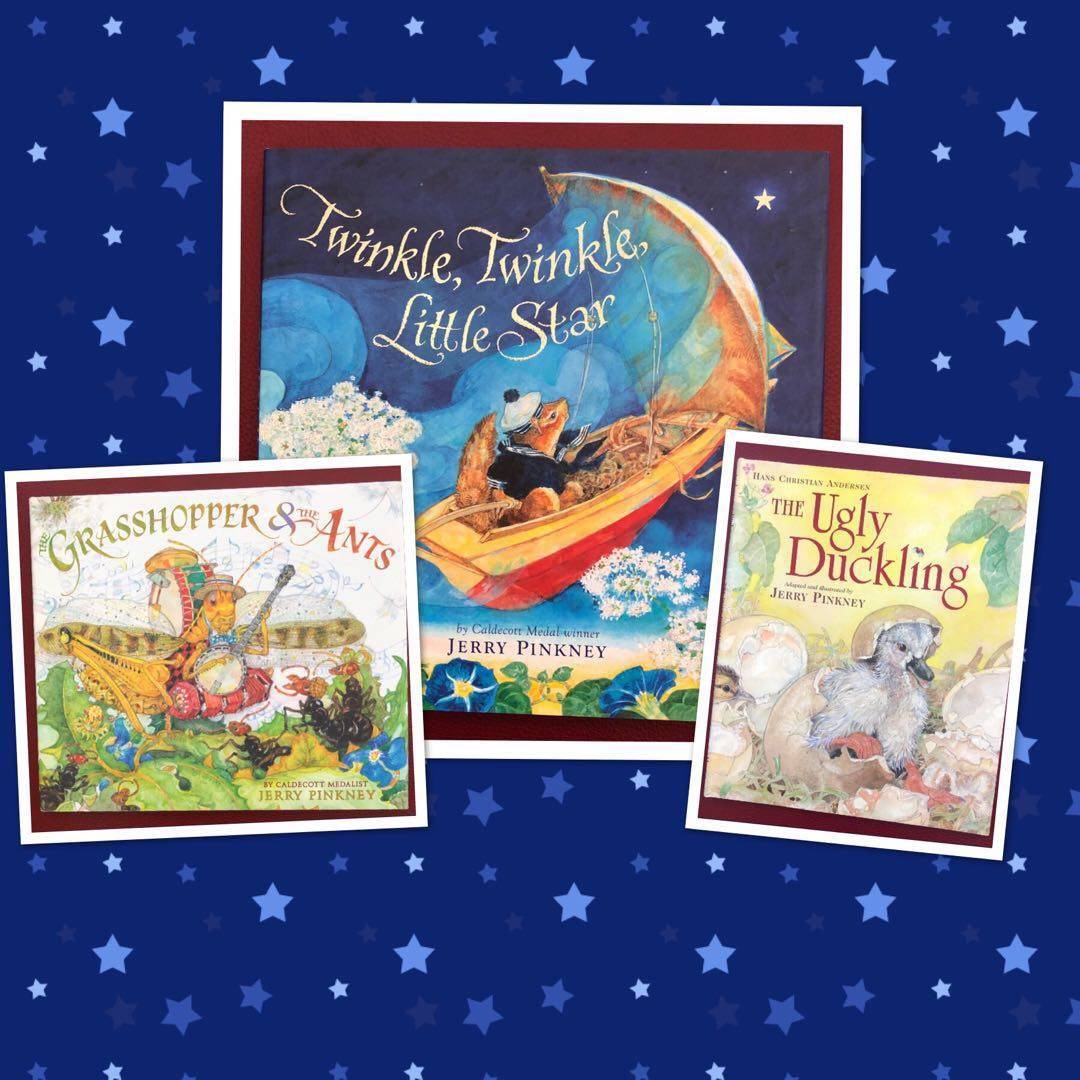”Why labor so long?” Grasshopper chirped. “It's summertime. Let's have a picnic of fresh, yummy leaves. Come join me in making music!”
”Why labor so long?” Grasshopper chirped. “It's summertime. Let's have a picnic of fresh, yummy leaves. Come join me in making music!”
The title illustrations are so fitting! Pinkney uses elements of the story like the characters (ants and the grasshopper) and settings (sticks and leaves) in the title pages.
Jerry Pinkney once again perfectly encapsulates the whimsical energy of a fable trough his illustrations. I would absolutely use this one to explore the moral of the fable with students. The story emphasizes traits like working hard, being prepared, but also being generous. Jerry Pinkney explains in his artist‘s note that he took liberties with the ending where he has the ants share what they have and the grasshopper learns his lesson.
“A cup of tea?” Asked Queen Ant.
“How kind of you,” said Grasshopper
This book is a good morning meeting book for pre-K through 2nd grade students. There is a valuable moral that can be discussed after the book is done. After the emphasis on play in Pre-K, this book would be good for early year kindergartners to learn the value of balancing work and play.
Originally one of Aesop‘s Fables, this retelling by Jerry Pinkney tells the story of a grasshopper who‘s all play, and the ants who are all work. Although he tries, the grasshopper has a hard time convincing the ants to take a break. When winter rolls around the grasshopper is alone in the cold, he is invited inside by the ants. Each learn the value of a work and play balance.
This fable shares the importance of putting work before play. It teaches young children how they should think about the future and be prepared. I can use this story in a classroom to highlight these topics as I complete literacy activities that revolve around discussion.
The Grasshopper & the Ants is a part of traditional literature as the story is a fable. This story describes how a hungry grasshopper is in search of food during the winter and begs an ant and is refused. The moral of the story teaches young children the importance of putting work before play as it is very important to do the things you need to do before the things you want to do.
The lesson that is taught in this fable is that sometimes you must put work before play because it is more important to do the things that must be done before the things you want to do. This story will be easy for students to follow because there really are so few words in it and it uses simple language to get the lesson across.
“The Grasshopper and the Ants“ is a classic Aesop fable that has been adapted many times before but it always has the fable feel to it. It follows a grasshopper that relaxes through spring, summer and fall while a colony of ants works gathering food for the winter. At first, they refuse grasshopper's request for help but in the end, they allow him in to share. It is considered a fable because it teaches a life lesson through the plot of the story.
“All you ants do is work all day. You should be more like me and play, play, play!”
This story has the message of putting work before play when you have things that need to be done. The grasshopper enjoys their summer doing things they enjoy, but not thinking of the future. When winter finally comes the grasshopper has to ask the ants for food due to their unpreparedness. The ants, who did work and prepared, are ready while the grasshopper is not.
This is one of the original Aesop's Fables. The story includes a grasshopper and ants. The grasshopper spends its time in the summer singing and doing other joyous things while the ants work hard to prepare for winter. The grasshopper does not get why the ants only work and the ants do not get why the grasshopper only sings. When winter comes the grasshopper asks the ants for food because he has none and they do not have enough to share.
I would use this book to teach my students about the important lesson of the balance between putting work before play, while also managing your time, using it wisely, and making the most of every moment.
“The Grasshopper & the Ants“ is a great example of fables within traditional literature. This is a short story, which includes cumulative repetition, that teaches a lesson: take advantage of the time you have, don't waste your life away! Also, it brings up the ant's perspective of putting work before play.
This book would be great to read at the beginning of the school year. It teaches the lesson of not putting things off until the load gets way too big. For example, the ants worked every day in Spring, Summer, and Fall so that they could be secure and relaxed during the winter. This can relate to school work.
The Grasshopper and the Ants is an example of a Cumulative story because of the use of repetition in the rhythm of the story. It also teaches the moral of not putting off for tomorrow what you can do today. The illustrator used magnificent colors and detail to demonstrate the story.
This book is colorful and displays a great timeline of the seasons. I think it shows how much work a person can put it and that it sometimes takes time.

This book is a great way to talk about the value of friendship and hard work.
This story published in 2015 is very one dimensional with its characters because it is more of a fable. The illustrations are incredibly beautiful and bright. The message there is very little dialogue but the illustrations make up for it.
The grasshopper and the ants , published in 2015 was a very cool read. With the lack of words it made the pictures tell the story even deeper. The illustration sucked you in right from the first page.
I like this book. The same author made the lion and the mouse. I like how two different animals come together as one and bond.
A great interpretation of a timeless fable that teaches us to work hard. It uses a pairing of two creatures together that become friends.
This book was published in 2015. The illustrations of seasons are really fun to look at and take you back into that season when on that page. The story line is okay but this book would be good for the younger ones trying to learn about friends and seasons.
This book is very different! It tells a cute story and even has several pages that tell the timeline of the story through only illustrations!
This is a magical book. It is also a Caldecott award winner by Jerry pinkey. The illustrations and text are both interesting and beautiful

Pinkney breathes new life into classic Daniels and other staples in the lives of young children. His illustrations are spectacular, each a true piece of art in its‘ own right. No wonder he has been recognized Caldecott so often! He is amazing!